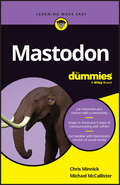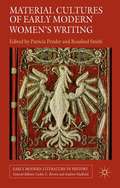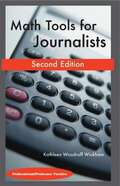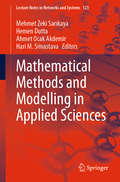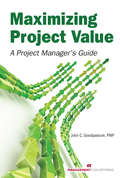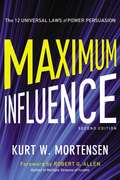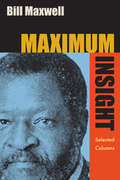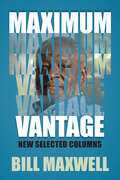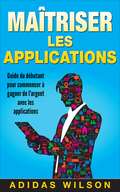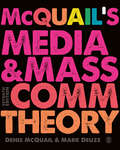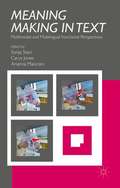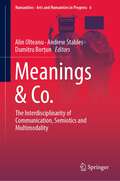- Table View
- List View
Mastodon For Dummies
by Chris Minnick Michael McCallisterA little birdy told us you needed to know more about Mastodon Ready to escape the drama of existing social media platforms and try something new and awesome in the world of social media? In Mastodon For Dummies, experienced tech trainers Chris Minnick and Mike McCallister show you exactly how to use Mastodon, the hot decentralized social media offering on the web and destination for thousands of social media migrants. Learn how to sign up for the service on your choice of server and get familiar with the rules of what’s sure to become your new favorite app. You’ll discover how to connect with other people, attract your own followers, and make yourself right at home in the Mastodon community. In the book, you’ll find: Easy-to-follow instructions on how to choose the Mastodon server that suits you best Instructions for establishing new connections on a new social platform and learning the rules of the road Tips for conducting business on Mastodon and making a home for your home-based business or brand on the social media service Step-by-step guides on launching your very own serverIf you’re ready to leave old social platforms in the rear-view and try something new, grab a copy of Mastodon For Dummies.
Material Cultures of Early Modern Women’s Writing
by Patricia Pender Rosalind SmithThis collection examines the diverse material cultures through which early modern women's writing was produced, transmitted, and received. It focuses on the ways it was originally packaged and promoted, how it circulated in its contemporary contexts, and how it was read and received in its original publication and in later revisions and redactions.
Material Texts in Early Modern England
by Adam SmythWhat was a book in early modern England? By combining book history, bibliography and literary criticism, Material Texts in Early Modern England explores how sixteenth- and seventeenth-century books were stranger, richer things than scholars have imagined. Adam Smyth examines important aspects of bibliographical culture which have been under-examined by critics: the cutting up of books as a form of careful reading; book destruction and its relation to canon formation; the prevalence of printed errors and the literary richness of mistakes; and the recycling of older texts in the bodies of new books, as printed waste. How did authors, including Herbert, Jonson, Milton, Nashe and Cavendish, respond to this sense of the book as patched, transient, flawed, and palimpsestic? Material Texts in Early Modern England recovers these traits and practices, and so crucially revises our sense of what a book was, and what a book might be.
Math Tools For Journalists: Professor/Professional Version
by Kathleen Woodruff WickhamCovers common math concepts such as percentages, statistics, business math, property taxes, polls/surveys, probability, and stocks and bonds.
Mathematical Methods and Modelling in Applied Sciences (Lecture Notes in Networks and Systems #123)
by Hari M. Srivastava Hemen Dutta Mehmet Zeki Sarıkaya Ahmet Ocak AkdemirThis book presents a collection of original research papers from the 2nd International Conference on Mathematical and Related Sciences, held in Antalya, Turkey, on 27 – 30 April 2019 and sponsored/supported by Düzce University, Turkey; the University of Jordan; and the Institute of Applied Mathematics, Baku State University, Azerbaijan. The book focuses on various types of mathematical methods and models in applied sciences; new mathematical tools, techniques and algorithms related to various branches of applied sciences; and important aspects of applied mathematical analysis. It covers mathematical models and modelling methods related to areas such as networks, intelligent systems, population dynamics, medical science and engineering, as well as a wide variety of analytical and numerical methods. The conference aimed to foster cooperation among students, researchers and experts from diverse areas of mathematics and related sciences and to promote fruitful exchanges on crucial research in the field.This book is a valuable resource for graduate students, researchers and educators interested in applied mathematics and interactions of mathematics with other branches of science to provide insights into analysing, modelling and solving various scientific problems in applied sciences.
Mathematical Theories of Machine Learning - Theory and Applications
by Bin Shi S. S. IyengarThis book studies mathematical theories of machine learning. The first part of the book explores the optimality and adaptivity of choosing step sizes of gradient descent for escaping strict saddle points in non-convex optimization problems. In the second part, the authors propose algorithms to find local minima in nonconvex optimization and to obtain global minima in some degree from the Newton Second Law without friction. In the third part, the authors study the problem of subspace clustering with noisy and missing data, which is a problem well-motivated by practical applications data subject to stochastic Gaussian noise and/or incomplete data with uniformly missing entries. In the last part, the authors introduce an novel VAR model with Elastic-Net regularization and its equivalent Bayesian model allowing for both a stable sparsity and a group selection.
Mathematical and Physical Fundamentals of Navigation and Positioning with Earth's Natural Fields (Navigation: Science and Technology #13)
by An Li Yang Li Lei Yan Wanfeng JiThis book covers various fields relevant to navigation, including Earth's magnetic field, gravity field, topography, celestial polarization field, electrostatic field, and relativistic celestial field effects. It introduces the principles and applications of navigation positioning using various natural field navigation and terrain-assisted methods, including gravity field navigation positioning, geomagnetic field navigation positioning, terrain-assisted navigation positioning, polarization field navigation positioning, electrostatic field navigation positioning, and relativistic effect verification. This book comprehensively introduces the algorithm principles and engineering implementation approaches, providing basic theoretical support for precision navigation positioning and deep space exploration. Based on the principles of gravity, geomagnetic, and terrain-assisted navigation positioning, corresponding to the universal gravitational force and Earth's rotation in Newtonian mechanics, it combines polarization field navigation positioning with the energy field effect of solar incident light waves, as well as electrostatic field navigation positioning with relativistic effect verification. This forms a relatively complete theoretical technical system and abstracts the mathematical essence of each link in the geomagnetic, gravity, and terrain navigation positioning systems. Taking mechanism exploration and algorithm implementation as the basic approach, it has confirmed the theoretical correctness and practical feasibility of natural field navigation positioning through verification with actual measurement data. This book is mainly targeted at professionals, researchers, students, and readers interested in deep space, deep Earth, deep sea, and polar exploration, as well as those working in the field of navigation positioning. It is of reference value in deep space, deep Earth, and deep sea exploration.
Mathematische Grundlagen der Digitalisierung: Kompakt, visuell, intuitiv verständlich (essentials)
by Tatjana Lange Jörg LangeDie Autoren klassifizieren kurz die in Natur und Technik auftretenden Signale und stellen die Ecksteine der „analogen“ Fourier-Transformation als Basis für das essential dar. Sie zeigen anschaulich den Zusammenhang von Periodifizierung und Abtastung von Signalen im Zeit- und Frequenzbereich und leiten daraus das für die Digitalisierung fundamentale Abtasttheorem ab. Darauf aufbauend wird weitgehend visuell die diskrete Fourier-Transformation erklärt und deren Handhabung an einem Rechenbeispiel gezeigt. Es folgt eine Kurzdarstellung ausgewählter Grundbausteine der Übertragungstechnik und eine robuste Erläuterung des Mehrträger-Verfahrens und des orthogonalen Frequenzmultiplexverfahrens OFDM als Kernstück der Signalübertragung im Internet.Die Autoren:Prof. Dr.-Ing. habil. Jörg Lange war in leitender Position im Entwicklungsbereich Mobilfunk in einem Technologiekonzern tätig, bevor er in Ruhestand ging. Prof. Dr.-Ing. Tatjana Lange lehrte vor ihrem Ruhestand Automatisierungstechnik an der Hochschule Merseburg und ist weiterhin in der Forschung aktiv.
Matrix Activism: Global Practices of Resistance (Routledge Research in Cultural and Media Studies)
by Michela ArdizzoniThe intersection of virtual and physical spaces at the heart of contemporary political protests is a pivotal element in new practices of activism. In this new and global ecology of dissent and activism, different forces, stakeholders, and spaces, once defiantly discordant, come together to define the increasingly malleable nature and terms of participatory politics and the performance of democracy. This book explores the emerging sites, aesthetics and politics of contemporary dissent as a critical attempt to foreground their mediation and negotiation in an era of neoliberal globalization. Contemporary forms of media activism occupy deeply ambivalent spaces, which Ardizzoni analyzes using the lens of what she calls "matrix activism." Rather than confining the analysis to a single platform, a single technology, or a single social actor, matrix activism allows us to explain the hybrid nature of new forms of dissent and resistance, as they are located at the intersection of alternative and mainstream, non-profit and corporate, individual and social, production and consumption, online and offline.
Max Weber, China und die Medien: Zwei Studien zum 150. Geburtstag des Soziologen (essentials)
by Siegfried Weischenberg Dirk KaeslerIn der ersten Studie werden Max Webers Anregungen für eine Mediensoziologie im Rahmen von allgemeinen Überlegungen zur Wissenschaftsforschung untersucht. Im Zentrum steht dabei die These, dass in einschlägigen Studien grundsätzlich die Bibliographie von Wissenschaftlern Vorrang haben sollte vor biographischen Details. In der zweiten Studie werden Max Webers Untersuchungen der zwei großen religiösen Ordnungen des traditionellen China, des Konfuzianismus und Taoismus behandelt. Vor Webers innerem Auge stand ein riesiges Kaiserreich, in dem die „Literaten“ die herrschende Schicht stellten, in dem literarische Bildung Maßstab sozialen Prestiges war und in dem diese führende Intellektuellenschicht der entscheidende Träger der Kultur gewesen sein soll und deswegen in einer besonders intimen Beziehung zum Kaiser stand.
Max Weber, China und die Medien: Zwei Studien zum 150. Geburtstag des Soziologen (essentials)
by Siegfried Weischenberg and Dirk KaeslerIn der ersten Studie werden Max Webers Anregungen für eine Mediensoziologie im Rahmen von allgemeinen Überlegungen zur Wissenschaftsforschung untersucht. Im Zentrum steht dabei die These, dass in einschlägigen Studien grundsätzlich die Bibliographie von Wissenschaftlern Vorrang haben sollte vor biographischen Details. In der zweiten Studie werden Max Webers Untersuchungen der zwei großen religiösen Ordnungen des traditionellen China, des Konfuzianismus und Taoismus behandelt. Vor Webers innerem Auge stand ein riesiges Kaiserreich, in dem die „Literaten“ die herrschende Schicht stellten, in dem literarische Bildung Maßstab sozialen Prestiges war und in dem diese führende Intellektuellenschicht der entscheidende Träger der Kultur gewesen sein soll und deswegen in einer besonders intimen Beziehung zum Kaiser stand. Der Inhalt Biografie, Bibliografie und Bibliometrie: Wissenschaftsforschung am Beispiel von Max Webers Mediensoziologie.- Der Traum von der Herrschaft der Literaten: Max Weber über China Die ZielgruppenDozierende und Studierende der Medien- und Kommunikationswissenschaft. Die Autoren Dr. Siegfried Weischenberg ist seit mehr als drei Jahrzehnten als Professor an Universitäten im In- und Ausland tätig; er hat zahlreiche große empirische Studien zum Journalismus durchgeführt. Dr. Dirk Kaesler ist Professor für Allgemeine Soziologie an der Philipps-Universität Marburg. Er gehört zu den führenden Weber-Forschern.
Maximizing Project Value: A Project Manager's Guide
by John Goodpasture PMPIncrease Project Value = Attain the GoalMaximizing project value is about optimizing the tradeoff between project value and business value, two values that are constantly in tension between the project manager and the project sponsor. In this book the author brings his wealth of experience in project management to demonstrate how to increase a project's value and ultimately contribute to the attainment of business goalsFrom exploring the nature of "value," as tangible resources and moral or ethical attributes, to how best to approach decision-making, the book offers thorough coverage of this essential aspect of project management. The tools and methods the author describes include:• Building the business case• Using a project balance sheet• Employing earned value• Introducing game theory for optimizing strategiesThis valuable reference should be on the desk of every project sponsor, business stakeholder, project manager, portfolio manager, project practitioner, and functional manager.
Maximum Exposure (The\heartlands Ser.)
by Jenny HarperShe’s a professional photographer – but is she ready to expose her heart?Adorable but scatterbrained newspaper photographer Daisy Irvine becomes the key to the survival of The Hailesbank Herald when her boss drops dead right in front of her. And while big egos and petty jealousies hinder the struggle to save the paper, Daisy starts another campaign – to win back her ex, Jack Hedderwick.Ben Gillies, returning after a long absence, sees childhood friend Daisy in a whole new light. He’d like to win her love, but discovers that she’s a whole lot better at taking photographs than making decisions, particularly when she’s blinded by the past.When tragedy strikes Daisy’s family, loyalty drives her home. But it’s time to grow up and Daisy must choose between independence and love.
Maximum Influence: The 12 Universal Laws of Power Persuasion
by Robert G. Allen Kurt W. MortensenSalespeople, consultants, managers, executives, entrepreneurs. . . Influence is a crucial tool for absolutely anyone seeking success and prosperity. But how can everyday people actually become more influential? Maximum Influence unlocks the secrets of the master influencers. Now in an all-new edition, the book combines scientific research with real-world studies, presenting the most authoritative and effective arsenal of persuasion techniques ever. Author and renowned expert Kurt Mortensen reveals the 12 Laws of Persuasion, explaining why each law works, how to use it, and what to avoid. You will learn about the law of dissonance, the law of contrast, the law of expectation--and nine other proven principles that consciously and unconsciously propel people to act. You willalso discover how to: * Read anyone instantly * Get people to trust you instinctively * Change minds easily * And convince anyone to give you almost anything. With new case studies and cutting-edge influencing techniques, this is the ultimate guide to the art and science of getting exactly what you want--when you want.
Maximum Insight: Selected Columns
by Bill Maxwell"One of the most distinctive and independent voices in American journalism . . . a voice that can inspire and infuriate . . . a voice that must not be ignored, especially if we Americans hope to create in this next century something that looks vaguely like a multi-racial, multi-ethnic democracy."--Roy Peter Clark, Poynter Institute, St. Petersburg"Maxwell’s level of erudition is unusual among columnists . . . he often alludes to history, philosophy, literature, and the social sciences as he puts the news of the day into context."--Sam G. Riley, professor of communication studies, Virginia Polytechnic Institute"An original and significant contribution to the literature of journalism and Florida culture."--Jay Black, Poynter-Jamison Chair in Media Ethics, University of South FloridaWith syndication in more than 200 newspapers and a faithful readership nationwide, Bill Maxwell’s status as one of the country’s preeminent black journalists is unquestionable. This collection of his columns, primarily from the St. Petersburg Times, forms a body of commentary on humanity (and lack of same) that will capture the hearts and minds of Americans. Maxwell covers a sweeping range of subjects, including race—a central but not exclusive theme. He asks hard questions that courageously attempt to understand hatred and injustice in America; and he takes on controversial issues many columnists avoid and a wide spectrum of national figures—from Jeb, George W. and Clarence Thomas to the Pope and Jesse Jackson. Maxwell writes movingly about his childhood as the son of migrant farm workers in rural Florida, his love of books—beginning with those plucked from garbage cans—and his everyday encounters with the white world and the black one. With a voice that is provocative and insights that are deep and passionate, he tackles the plight of migrant workers, the devastation of the environment, religious intolerance, homophobia, affirmative action, illiteracy, public education, civic responsibility, politics—and racism. He criticizes blacks and whites alike in his search for truth and right, especially in his exploration of what he calls "resurgent bigotry and Republicanism" and "the black writer’s most agonizing task—and duty—being dispassionate about the foibles and self-destructive behavior of African-Americans." Setting a standard for the newspaper column as social criticism, Maximum Insight illuminates the role of the black writer as an interpreter of the forces that define a diverse America.Bill Maxwell writes a twice-weekly column for the St. Petersburg Times. Syndicated by the New York Times News Service and by Scripps-Howard, his columns appear in 200 newspapers worldwide and have received many writing awards, including the Florida Press Club’s plaque for general excellence in commentary twice in and the Community Champion Award from the American Trial Lawyers Association.
Maximum Vantage: New Selected Columns
by Bill MaxwellA veteran journalist speaks truth to power on issues that matter to the nation In this collection of columns spanning the years 2000-2019, veteran journalist Bill Maxwell tackles important issues faced by Florida and broader American society that remain as relevant as ever. Demonstrating the courage to take on controversy and the signature pithy style that have won him a nationwide readership, Maxwell offers his opinion on a wide variety of questions with a focus on race, agricultural labor, education, and the environment. Maxwell writes from the vantage point of a Florida native who grew up as a migrant farmworker at the end of the Jim Crow era; a Black man who participated in the civil rights movement to help make the state more equitable; a college professor who lectured about the harms of racial discrimination; and an environmentalist who has lived in the Everglades as artist-in-residence. Grounding his social criticism in firsthand knowledge of the contradictions of life in the American South, Maxwell uses reason and research to highlight uncomfortable realities and injustices that persist in the twenty-first century.Believing that informed citizens will make decisions that positively impact society, Maxwell prompts readers to examine their own perspectives, question their assumptions, and come to a deeper understanding of their state and nation. Publication of this work made possible by a Sustaining the Humanities through the American Rescue Plan grant from the National Endowment for the Humanities.
May Contain Lies: How Stories, Statistics, and Studies Exploit Our Biases—And What We Can Do about It
by Alex EdmansHow our biases cause us to fall for misinformation—and how to combat it. Our lives are minefields of misinformation. It ripples through our social media feeds, our daily headlines, and the pronouncements of politicians, executives, and authors. Stories, statistics, and studies are everywhere, allowing people to find evidence to support whatever position they want. Many of these sources are flawed, yet by playing on our emotions and preying on our biases, they can gain widespread acceptance, warp our views, and distort our decisions. In this eye-opening book, renowned economist Alex Edmans teaches us how to separate fact from fiction. Using colorful examples—from a wellness guru’s tragic but fabricated backstory to the blunders that led to the Deepwater Horizon disaster to the diet that ensnared millions yet hastened its founder’s death—Edmans highlights the biases that cause us to mistake statements for facts, facts for data, data for evidence, and evidence for proof. Armed with the knowledge of what to guard against, he then provides a practical guide to combat this tide of misinformation. Going beyond simply checking the facts and explaining individual statistics, Edmans explores the relationships between statistics—the science of cause and effect—ultimately training us to think smarter, sharper, and more critically. May Contain Lies is an essential read for anyone who wants to make better sense of the world and better decisions.
Maîtriser les applications: Guide du débutant pour commencer à gagner de l'argent avec les applications
by Adidas WilsonLes technologies de la communication évoluent constamment pour suivre l’époque. Les applications de messagerie sont énormes en ce moment. Dépasser complètement les médias sociaux en devenant le principal moyen de communication en ligne. Lorsque la plupart des entrepreneurs débutent, ils aiment lire des articles sur «comment tuer avec votre première application», «créer l'application de plusieurs milliards de dollars» et la plupart des livres liés à ce sujet. Ils sont collés à ce côté de l'histoire et aveuglés à l'autre. Pour avoir votre propre réussite, vous devez découvrir pourquoi d'autres applications échouent. La triste vérité est qu'il y a plus d'applications qui ont échoué que celles qui ont réussi.
McGraw-Hill's Conversational American English: The Illustrated Guide to the Everyday Expressions of American English
by Betty J. Birner Richard A. Spears Steven Racek Kleinedler Luc NissetAs a new speaker of English, you may hear some expressions in your daily conversations that you do not understand--yet. McGraw-Hill's Conversational American English will help you learn these expressions, so not only do you know what a person is saying to you, but that you can use the expression yourself! More than 3,000 expressions are organized by theme, so you can find what you are looking for quickly. And each topic is illustrated to further help you understand context. The book features: Common expressions are batched into 350 themes, ranging from general greetings and asking how someone is, to the more specific needs, like showing disbelief, asking someone's intentions, and expressions for a forgotten word or name A comprehensive thematic glossary provides an additional means for the learner to locate expressions by key words and concepts Topics include: Basic Social Encounters, Greetings, Small Talk, Introductions, Ending a Conversation, Good-Byes, Agreeing, Disagreeing Conversational Encounters, Focusing Attention, Launching the Conversation, Making Friends, Complex Matters, Disputes, Discussion and Resolution, Polite Encounters, Prefaces, Communication Barriers
McQuail’s Media and Mass Communication Theory
by Mark Deuze Professor Denis McQuailNow in its seventh edition, this landmark text continues to define the field of media and mass communication research, offering a uniquely detailed, broad, and balanced guide. It maintains the narrative into the world of pervasive, ubiquitous, mobile, social and always-online media that we live in today. New to this edition: • Examples are now integrated within each chapter around politics and the public sphere, as popular culture and politics become more regularly intertwined. • An increased focus on conceptualizing &‘mass&’ media and communication and media theory in an age of big data, such as algorithmic culture, AI, platform economies, streaming, and mass self-communication. • Further discussion of what we want and expect of media and society in all chapters. • New and revised material, including a new chapter &“A Canon of Media Effects&”, bringing together Social-Cultural Effects & News, Public Opinion and Political Communication, helping the reader to rethink and reframe the whole idea of media effects and influence. A vitally important for all students of Media and Mass Communication in the 21st century.
McQuail’s Media and Mass Communication Theory
by Mark Deuze Professor Denis McQuailNow in its seventh edition, this landmark text continues to define the field of media and mass communication research, offering a uniquely detailed, broad, and balanced guide. It maintains the narrative into the world of pervasive, ubiquitous, mobile, social and always-online media that we live in today. New to this edition: • Examples are now integrated within each chapter around politics and the public sphere, as popular culture and politics become more regularly intertwined. • An increased focus on conceptualizing &‘mass&’ media and communication and media theory in an age of big data, such as algorithmic culture, AI, platform economies, streaming, and mass self-communication. • Further discussion of what we want and expect of media and society in all chapters. • New and revised material, including a new chapter &“A Canon of Media Effects&”, bringing together Social-Cultural Effects & News, Public Opinion and Political Communication, helping the reader to rethink and reframe the whole idea of media effects and influence. A vitally important for all students of Media and Mass Communication in the 21st century.
Me lo tenía merecido: Una memoria
by Pepe EliaschevUno de los periodistas más respetados de la Argentina se anima a mostrarsu intimidad, con una colección de viñetas sobre su infancia, losprimeros amores, el periodismo, la familia, el fútbol y otras pasiones. Pepe Eliaschev se anima a algo que muy pocos periodistas pueden hacerhoy en la Argentina: se para sobre el presente y mira hacia atrás supropia vida, sin ira ni indulgencia, y repasa los momentos clave,echando mano tanto a la emoción del relato íntimo como al punzante rigorpropio de las mejores armas del periodismo. Eliaschev confiesa que havivido y revela viñetas de aquellos días de niño judío en Buenos Aires,mimado por sabias abuelas #rusas#con exquisiteces culinariasinmemoriales; anécdotas de su paso como estudiante politizado por elNacional Buenos Aires; páginas de una adolescencia siempre bajo laimpronta de erotismos desbordantes; o los tempranos inicios comoaprendiz de periodista capaz de ver en los maestros virtudes y miserias.El Pepe adulto entra en escena con una mirada crítica y aguda hacia laviolencia política, que deriva en un exilio en el que armonizan, pese atodo, ausencias, pérdidas y construcciones vitales (una familia, unacarrera, una idea del mundo). Del hincha de Racing al corresponsal deguerra, de ser hijo a ser padre y abuelo, de días resplandecientes aotros realmente oscuros, un tránsito en el que va conformándose unEliaschev acaso secreto pero en inconfundible primera persona. Es decir,expuesto a través de los ya acreditados matices de su vozcaracterística, de esa voluntad permanente de aunar datos con conceptos,de una manera de decir que le da forma a este recorrido biográficoúnico.
Mean Field Game and its Applications in Wireless Networks (Wireless Networks)
by Zhu Han Reginald A. Banez Lixin Li Chungang YangThis book covers the basic theory of mean field game (MFG) and its applications in wireless networks. It starts with an overview of the current and future state-of-the-art in 5G and 6G wireless networks. Then, a tutorial is presented for MFG, mean-field-type game (MFTG), and prerequisite fields of study such as optimal control theory and differential games. This book also includes a literature survey of MFG-based research in wireless network technologies such as ultra-dense networks (UDNs), device-to-device (D2D) communications, internet-of-things (IoT), unmanned aerial vehicles (UAVs), and mobile edge networks (MENs). Several applications of MFG and MFTG in UDNs, social networks, and multi-access edge computing networks (MECNs) are introduced as well.Applications of MFG covered in this book are divided in three parts. The first part covers three single-population MFG research works or case studies in UDNs including ultra-dense D2D networks, ultra-dense UAV networks, and dense-user MECNs. The second part centers on a multiple-population MFG (MPMFG) modeling of belief and opinion evolution in social networks. It focuses on a recently developed MPMFG framework and its application in analyzing the behavior of users in a multiple-population social network. Finally, the last part concentrates on an MFTG approach to computation offloading in MECN. The computation offloading algorithms are designed for energy- and time-efficient offloading of computation-intensive tasks in an MECN. This book targets advanced-level students, professors, researchers, scientists, and engineers in the fields of communications and networks. Industry managers and government employees working in these same fields will also find this book useful.
Meaning Making in Text
by Carys Jones Sonja Starc Arianna MaioraniMeaning Making in Text extends the notion of text as a vehicle for ever-changing and complex forms of communication. Based on recent developments in Systemic Functional Linguistics (SFL), it proposes a range of analytical tools for accessing a variety of discourses in different contexts. The book presents studies of linguistic and multimodal phenomena concerning English and minority European languages that, until now, have received very limited attention, and offers proposals for analysingtext in terms of their application to pedagogy. The contributors demonstrate the increasingly rich potential of SFL to provide a refreshingly powerful account of human nature and the ways it can be applied that go well beyond those to do with language itself.
Meanings & Co.: The Interdisciplinarity of Communication, Semiotics and Multimodality (Numanities - Arts and Humanities in Progress #6)
by Alin Olteanu Andrew Stables Dumitru BorţunThis book explores the interdisciplinarity of semiotics and communication studies, comprising both theoretical explorations and semiotic applications to communication with theoretical bearings. These disciplines have generally been understood as mutually implicit, but there still are many unexplored research avenues in this area, particularly on a conceptual level. The book offers broad insights into the epistemological relations between semiotics and other approaches to communication from perspectives such as sociology, philosophy of language and communication theory. As such, it sheds light on the communication of knowledge.Semiotics is currently enjoying increasing popularity within the humanities and social sciences. Understood as relational logic (Charles Peirce) or hermeneutics (structuralism and poststructuralism), semiotics fundamentally implies certain positions with regard to communication. Because of the generality and conceptual vagueness of semiosis and communication, how one elucidates the other is still an underexplored theme. With some pioneering studies of this relation, the books examines various fields, such as language, code, learning, embodiment, political communication, media, cinema, cuisine, multimodality and intertextuality.
